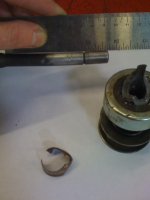Eric.C
Contributing Member
Just when it seemed we were getting all our gremlins exterminated, we took the Cheap Hooker out yesterday for a little inshore fishing. About four miles out, we decided to give her a WOT test. We hit JUST over 3k revs, then starboard started randomly popping out the carb. Back her down below 3k, and everything went back to smooth, quiet, and good power. Tried again a mile-or-so later, same deal. We could cruise at 2600 revs no problem, but if we throttled up past 3k, backfires. To note: we have NEVER had the engines over 3k. WOT just would not break 3k before. We have done quite a few things (cable adjustment being a major one) and are now getting 3k at about 60-70% throttle, so we wanted to see what she would do now, but even with more throttle to play with, she gagged at anything over 3k.
Sooo... I have not yet checked the TA on the timing, but I know the initial is good at 10 degrees. On Delco EST's, if I am not getting the full 22 degrees of advance (total 32) out of the distributor, what would cause this? Replace the entire distributor? Coil? Pickup? What actually handles the advance on these?
If the TA checks good, what would be your next suggestions? I will not make it back up to the boat until I return from Kaui, but I would like to have a bit of a game-plan for when I do get up there.
UNRELATED TANGENT: It got better... we moved around, trying fishing a few different spots during the day, then when we decided to call it around 3pm, my brother fired up port, then went to crank starboard... starter free-spooled. He tried again, and it free-spooled again. This time it kept spinning after he turned the key back to off. Tried again, and popped the 50A breaker... sigh... turned out the starter solenoid was shorting out inside and staying engaged. Pulled the starter back at the slip, and the bendix gear was shattered... sigh again... Gonna be fun digging those pieces out of the bellhousing... Just tore down the starter at work today, and the armarture shaft is bent also... What the hell could have caused this? I know the "worst-case scenario", but temps/pressures were good, and I don't even want to THINK about THAT possibility right now! I was in the head and did not notice, but he said it STARTED to crank (he said the tach needle rose up a bit, then dropped as he heard the starter free-spooling). Correct starter, properly aligned... just an old starter had enough? One brass bushing inside is mangled (sits at base of armature shaft).

Sooo... I have not yet checked the TA on the timing, but I know the initial is good at 10 degrees. On Delco EST's, if I am not getting the full 22 degrees of advance (total 32) out of the distributor, what would cause this? Replace the entire distributor? Coil? Pickup? What actually handles the advance on these?
If the TA checks good, what would be your next suggestions? I will not make it back up to the boat until I return from Kaui, but I would like to have a bit of a game-plan for when I do get up there.
UNRELATED TANGENT: It got better... we moved around, trying fishing a few different spots during the day, then when we decided to call it around 3pm, my brother fired up port, then went to crank starboard... starter free-spooled. He tried again, and it free-spooled again. This time it kept spinning after he turned the key back to off. Tried again, and popped the 50A breaker... sigh... turned out the starter solenoid was shorting out inside and staying engaged. Pulled the starter back at the slip, and the bendix gear was shattered... sigh again... Gonna be fun digging those pieces out of the bellhousing... Just tore down the starter at work today, and the armarture shaft is bent also... What the hell could have caused this? I know the "worst-case scenario", but temps/pressures were good, and I don't even want to THINK about THAT possibility right now! I was in the head and did not notice, but he said it STARTED to crank (he said the tach needle rose up a bit, then dropped as he heard the starter free-spooling). Correct starter, properly aligned... just an old starter had enough? One brass bushing inside is mangled (sits at base of armature shaft).


